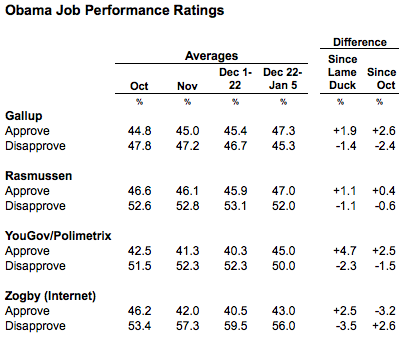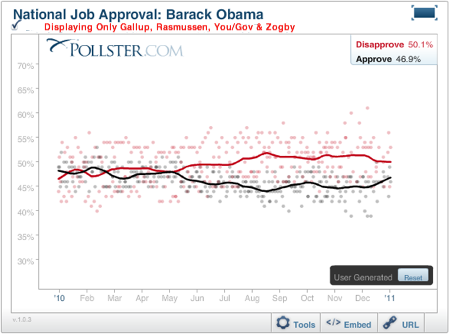
WASHINGTON -- Did President Obama get a bump in the polls after the successes of the congressional lame-duck session? While only a handful of pollsters have updated their job-approval numbers since the holidays, those who have seem to be showing movement in Obama's favor, though the change is slight and may be fleeting.
The question came up earlier this week when Obama's approval percentage in Gallup's daily tracking rose to 50 percent for the first time since June. His approval ratings have been "in the mid-40% range" since last Summer, as Gallup reported on Monday.
Over the last three days, Obama's approval rating has fallen slightly back to 48 percent. However, the average of the three non-overlapping samples released by Gallup since Dec. 22 give Obama an average rating of 47.3 percent, roughly two points higher than earlier in December (45.4 percent), and slightly better still than in November (45.0 percent) and October (44.8 percent). While a two-point difference is small, given the large numbers of interviews available from the pooled sample (roughly 4,500 since Dec. 22, more than 10,000 earlier in the month), these small differences are statistically meaningful.

Other pollsters have found trends in the same direction. Rasmussen Reports also tracks presidential approval on a daily basis, using an automated methodology to interview "likely voters" via their landline phones. Averaging their results for the same time period shows Obama's rating rising about a full percentage point since the holidays, from 45.9 percent in the first three weeks of December to 47.0 percent since. Rasmussen also shows a nominal improvement since October, though that change is smaller still.
Two firms that conduct surveys using only an "opt-in" panel of respondents who agree to be interviewed -- YouGov/Polimetrix and Zogby International -- have also released surveys in the past week. Both show improvement for Obama compared to their results in early December, although Zogby showed Obama doing slightly better in October than at present.
Thus, we have a consistent pattern: Gallup's survey alone shows a modest but statistically significant improvement in Obama's approval rating, and all four pollsters show nominal gains in the president's favor. As such, the change is likely real. The more important questions are whether this modest difference is meaningful and whether it is likely to persist.
We can put these numbers into better perspective by using the filter tool on our job-approval chart to mash up the results into one set of trend lines. You can see the small uptick in the black approval line and a similar dip in the red disapproval line, but we have seen similar momentary variation just in the last year. So the change may turn out to be statistically "real" yet short-lived. Only time will tell.
Keep in mind that, for a variety of reasons, the Rasmussen and Zogby results are typically more negative for Obama than other pollsters.
Also, as Nate Silver explained Wednesday, presidential approval ratings measured midway through the first term have proven to be weak predictors of the president's reelection prospects. Five presidents since Franklin Roosevelt have received a Gallup approval rating at or under 50 percent at the end of their first term. Three -- Truman, Reagan and Clinton -- went on to win reelection; only Ford and Carter did not. The approval rating will matter more as we get closer to Election Day 2012, so it's worth watching. But a one or two-point month-to-month change at this point is not exactly a political earthquake.

